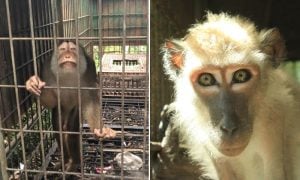Around the world, animal rights organizations are constantly fighting for the lives and wellbeing of species around the world. But what legal protections are actually in place, globally? And how do we rank as a nation?
World Animal Protection created an amazing tool in 2014, the Animal Protection Index, including an interactive map, allowing users to learn about and compare animal protection legislations of over 50 countries around the world.
The index’s key indicators are: recognition of animal sentience and existence of anti-cruelty legislation, whether animal welfare laws exist, government accountability or lack thereof, and whether internationally recognized animal welfare standards are supported.
The map ranks countries from A-G (A being the best, G being the worst). We’ve provided a selection for each ranking—and as you’ll see, the United States is (still) lagging far behind in comparison to countries with the best animal welfare laws.
B. UNITED KINGDOM
Along with Austria, Denmark, the Netherlands, and Switzerland, the UK is at the top of the list for most protections for animals. There is legislation preventing cruelty against animals in captivity, wild animals, and farm animals. In 2011 The Animal Welfare Act passed, recognizing all vertebrates as sentient, feeling beings. In addition, enforcement mechanisms are in place and punishments for breaking laws, such as fines and imprisonment. They also support the Universal Declaration on Animal Welfare (UDAW), a move to encourage countries to agree upon and adopt a common set of standards protecting animals worldwide.
Also notable, Luxembourg is poised to become the country with the most extensive animal rights laws in the world.
C. GERMANY
The German Animal Welfare Act recognizes that vertebrates, warm-blooded, and cold-blooded, including fish, amphibians, and cephalopods are capable of feeling pain and suffering. All warm-blooded farm animals are required to be stunned before slaughter and regulations for the treatment of companion animals are specific and far-reaching. Stray dogs are never euthanized unless there is a health risk. These are all strong indicators that Germany is potentially making strides toward joining other countries with the best animal welfare laws. However, regulations on animals in zoos exist but are vague. Statements from the UDAW have been adopted, though the entire declaration has not.
C. INDIA
As we’ve seen, some of the strongest factors for determining the best or worst countries for animal rights in the world come down to considering sentience and federally recognized anti-cruelty legislation. In India, all non-human beings are recognized as having physical and mental feelings which are somewhat protected under law and have been since 1960. Though these laws provide guidelines for farm and companion animals, they are not applied universally throughout the country. Official standards exist for zoos and anti-cruelty rules are specified for companion animals. Though the Animal Welfare Board of India endorses the UDAW, the government as a whole does not.
D. UNITED STATES
If this was a grade in school, the U.S. would be doing pretty badly. While the country has some considerations for animals written into law, for the most part, we fall short. Legislation recognizes “some aspects of animal sentience in some animals.” The Animal Welfare Act calls for the humane treatment of some animals, however, there is no general anti-cruelty provision. Laws regulating slaughter do not apply to poultry and no laws apply to the rearing of farm animals. Though some state and local laws offer more protections for pets, no federal law exists to prevent cruelty by pet owners. In recent years, the U.S. also now holds an F-rating for protecting companion animals, with no federal laws to regulate how pets are treated (as this is often left to state laws to decide). Anti-tethering laws, anti-breeder legislation, laws to protect cats from declawing in certain states, and other state measures have been enacted toward the protection of companion animals, yet little, if any, federal oversight exists here.
There are notable positive steps forward, however:
E. CHINA
Though China is behind many in regards to animal rights in the world, changes are happening to make life better for animals. Animals in research labs, zoos, and meat and fur farms have some recognition of sentience and protection. Provisions and enforcement also exist for companion animals, however, the dog and cat meat trade incurs many protests from within the country and internationally.
E. RUSSIA
At the start of the Animal Protect Index in 2014, Russia was rated with an F, making it among the worst countries for animal cruelty and lack of animal rights in the world. Since then, there is some positive movement forward, but the country still has a lot of issues to account for (namely that a new law does not factor in animal testing, hunting, or consider farm animals). Federal Law ФЗ, enacted in December 2018, established the recognition of animal emotions (though without specifically citing sentience) and the responsibility humans have for animals. The government of Russia has nothing in place or in the works to improve conditions for animals. Originally, they had an F instead of a G because there are a few vague rules under environmental protection to manage endangered wild animals and the penal code that provisions against cruelty to animals in general. Unfortunately, cruelty is undefined and enforcement mechanisms are without guidelines.
G. IRAN
There is no legislation specifically created for the welfare of animals in Iran. A bill was brought forward in 2017 to enact some animal protections, criminalizing acts of animal cruelty; however, as of 2019, the bill that would forbid physical animal abuse was not enacted. That’s not to say that people aren’t sympathetic to animals’ plights; they may just live in fear of what will happen if they speak up. In the past, Iranians have been beaten and arrested at a demonstration for animal rights. According to the protection index, Iran is among the worst countries for animal cruelty, with the development of anti-cruelty legislation hanging in limbo since 2017.







